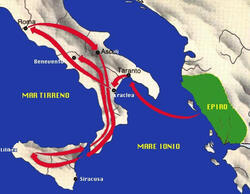In Ancient Rome there was a special order of high priests called Fetiales in charge of the relationships between Rome and its neighbors.
 These priests had another important task. They also linked the Romans to their divinities. In fact, the relationships, friendly or belligerent, between people had to be presented to the gods first.
These priests had another important task. They also linked the Romans to their divinities. In fact, the relationships, friendly or belligerent, between people had to be presented to the gods first.
The Fetiales were in charge of the ritual. In case of war, it was important for the Romans to get the gods on their side.
So Four Fetiales were always sent to the enemy’s land to perform the rite of Indictio Belli, where a spear was thrown in the soil to let the gods know that war was about to be fought.
Rich in significance is the episode described by the Roman author Servio (Aen. 9, 52) describing the occasion in which Rome declared war to Pyrrhus, King of Epirus (a land on the coast between modern Greece and Albania).
The land was on the other side of the Adriatic sea and it was too far away for the Romans to procede with the Indictio Belli.
So, a small unit of Roman soldiers were ordered to capture a man from the Epirus state and bring him to Rome. Once in the city, the man was forced by the Roman Senate to buy a small piece of land within the city walls by the Temple of Bellona, goddess of War. The land was immediately after declared by the Senate Ager Hostilis (literally “enemy’s land”).
This land, in other words, was no longer property of Rome.

Enjoy the view of the Temple of Bellona during the Jewish Quarter of Rome Tour!
The Fetiales were then sent to the land of the prisoner. They symbolically threw the spear and this is how Rome was able to declare war in 280 BC on King Pirro.
A column was later built on this spot to make it easier during the Republican Era for Rome to declare war on a non-border state.
Learn more about roman history during the Rome Squares and Fountains Walking Tour!


